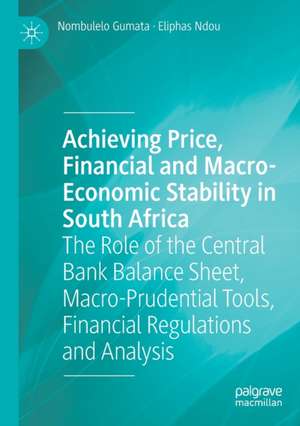Achieving Price, Financial and Macro-Economic Stability in South Africa: The Role of the Central Bank Balance Sheet, Macro-Prudential Tools, Financial Regulations and Analysis
Autor Nombulelo Gumata, Eliphas Ndouen Limba Engleză Paperback – 29 mai 2022
| Toate formatele și edițiile | Preț | Express |
|---|---|---|
| Paperback (1) | 736.81 lei 6-8 săpt. | |
| Springer International Publishing – 29 mai 2022 | 736.81 lei 6-8 săpt. | |
| Hardback (1) | 742.31 lei 6-8 săpt. | |
| Springer International Publishing – 28 mai 2021 | 742.31 lei 6-8 săpt. |
Preț: 736.81 lei
Preț vechi: 898.54 lei
-18% Nou
Puncte Express: 1105
Preț estimativ în valută:
140.99€ • 147.88$ • 117.37£
140.99€ • 147.88$ • 117.37£
Carte tipărită la comandă
Livrare economică 01-15 aprilie
Preluare comenzi: 021 569.72.76
Specificații
ISBN-13: 9783030663421
ISBN-10: 3030663426
Ilustrații: XLIV, 556 p. 361 illus., 69 illus. in color.
Dimensiuni: 148 x 210 mm
Greutate: 0.71 kg
Ediția:1st ed. 2021
Editura: Springer International Publishing
Colecția Palgrave Macmillan
Locul publicării:Cham, Switzerland
ISBN-10: 3030663426
Ilustrații: XLIV, 556 p. 361 illus., 69 illus. in color.
Dimensiuni: 148 x 210 mm
Greutate: 0.71 kg
Ediția:1st ed. 2021
Editura: Springer International Publishing
Colecția Palgrave Macmillan
Locul publicării:Cham, Switzerland
Cuprins
1. Introduction.- 2. Do capital inflows relieve banks’ credit constraints and boost credit growth? Evidence from credit conditions and bank credit risk.- 3. Credit conditions and the amplification of macroeconomic responses to unexpected shocks: Implications for monetary policy.- 4. Output and inflation responses to single and double credit threshold effects in South Africa.- 5. Do contractionary fiscal shocks transmitted via GDP growth dampen credit growth?.- 6. Do synchronised credit and house price booms impact the monetary policy reaction to inflationary pressures?.- 7. Do synchronised boom and non-boom episodes in credit, commodity and equity prices impact the response of the repo rate to positive inflation shocks?.- 8. To what extent do capital inflows impact response of South African economic growth to positive SA-US interest rate differential shocks?.- 9. Is there a compelling case to increase the SARB holdings of government securities to supplement interest income and neutralize loses due foreign investments and foreign currency reserves accumulation?.- 10. Are the amplification effects of positive shocks to SARB assets and forex reserves on long-term yields dependent on government debt regimes?.- 11. Foreign Currency Reserves: Do they contribute to GDP and employment growth?.- 12. What is the impact of large-scale asset purchases and banks’ balance sheets?.- 13. Is the interest rate corridor an effective instrument to dampen the accumulation of excess reserves and inter-bank rate volatility?.- 14. Is the impact of the unexpected positive required reserves ratio shock on inflation expectations different to that due to positive excess LAH and forex reserves shock?.- 15. How potent is the required reserves impact tightening shock on funding and consumer interest rates?.- 16. The impact of large-scale asset purchases on non-resident purchases of South African assets.- 17. Large scale asset purchases and activity in the primary and secondary share and bond markets.- 18. The stock and flow effects of large-scale asset purchases: Evidence from persistent vs transitory shocks.- 19. Has the inflation target band impacted the natural rate of unemployment in South Africa? Evidence from the accelerationist Philips curve.- 20. Do regulatory tools impact the transmission of capital inflow shocks into credit extension and induce the reallocation of sectoral credit shares?.- 21. What role do non-performing loans play in propagating the excess LAH shock effects on sectoral credit re-allocation?.- 22. Is excess CAR beneficial in neutralising excessive credit growth and inflationary pressures? What are the implications for monetary and financial policy?.- 23. Do non-performing loans propagate the transmission of monetary policy tightening shocks to sectorial credit?.- 24. How effective is the relaxation of the countercyclical capital buffer at a time when other residential macro-prudential tools are tight?.- 25. Revisiting the role of money demand function: Does the short fall in money demand impact the inflation responses of rand depreciation shocks?.- 26. Do the shortfalls and overhangs derived from money demand in South Africa augmented with portfolio balances impact inflation dynamics?.- 27. Do the exchange rate depreciation and volatility shocks impact money demand in South Africa?.- 28. Does economic policy uncertainty impact real money demand in South Africa?.- 29. Is a single sectorial credit growth threshold too restrictive? Evidence from the output and inflation.- 30. Does the threshold for household debt growth matter for GDP growth and response of monetary policy to inflation shocks?.- 31. How does a positive repo rate shock affect the household sector intermediation? Evidence from households’ flow-of-funds data.- 32. To what extent are the public and private’s sector financial asset flows impacted by monetary policy tightening shock?.
Notă biografică
Nombulelo Gumata is an economist at the South African Reserve Bank and has authored several books in the areas of international finance and macroeconomics, macro-prudential and regulatory tools and financial stability, labour markets, monetary and fiscal policy.
Eliphas Ndou is an economist at the South African Reserve Bank and has authored books in international finance, public finances, monetary, labour, macro and microeconomics, time-series econometrics, banking regulation and macro-prudential policy.
Textul de pe ultima copertă
This book explores the macro-financial effects of central bank balance sheets, macro-prudential tools, and financial regulation in South Africa. How employment can be maximised while keeping inflation low and stable is examined in relation to the structural changes required to alter the composition of South African bank balance sheets. Quantitative methods and approaches are utilised to highlight the impact of suggested policies.
This book aims to outline strategies and policy interventions that can help achieve the National Development Plan in South Africa. It will be of interest to researchers and policymakers working within development economics, African economics, development finance, and financial policy.
Caracteristici
Illustrates the use of SARB balance sheets to conduct large scale asset purchases Outlines a long term program for foreign currency reserve accumulation Examines the important role large scale asset purchases play in lowering government bond yields
